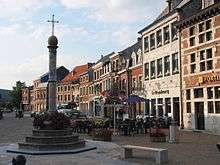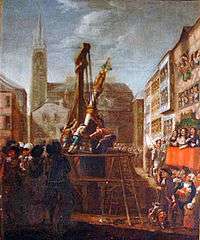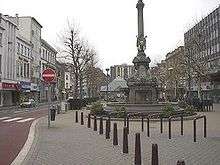Perron (architecture)

A perron (French; Dutch: perroen) is a stone column, often decorated with a globus cruciger, that was erected in cities belonging to the erstwhile Prince-Bishopric of Liège (980-1795). They were primarily built in the so-called Good Cities (French: Bonnes Villes, Dutch: Goede Steden) that formed the primary towns of the polity. Many survive, though not in their original form.
The columns came to symbolise local freedom and autonomy (initially bishopric autonomy, later urban autonomy). This stemmed from their function as place where laws were stated, and justice was administered. However, the actual origin of the symbols of the column is unclear. In 1467, after recapturing the rebellious city of Liège, Charles the Bold, Duke of Burgundy had the city's perron dismantled and removed to Bruges, not to be returned until after his death. This was "viewed both as a punishment of the people of Liège and as a clear warning to any Flemish subjects who might be tempted to question the duke's authority".[1]
Locations of perrons

The former cities of the Prince-Bishrophic where perrons have been built are nowadays located in multiple regions and provinces of Belgium, in addition to one in the Netherlands (that of Maastricht, which was a condominium of the Prince-Bishopric and the Duchy of Brabant during the Middle Ages). Perrons were also built in the Principality of Stavelot-Malmedy.
- Belgium
- Netherlands
Legacy
A perron is featured in the coat of arms of the city of Liège and has become a badge of the city. It is also featured on the cap badge of the 12th Regiment of the Line.
Gallery
Surviving perrons
-

Bilzen
-
Maastricht
-

Stavelot
-

Stokkem
-

Verviers
-

Visé
Perrons in art
-

Coat of arms of the Prince-Bishopric of Liège
-

Coat of arms of Liège
-

Coat of arms de Sint-Truiden
-

Coat of arms of Châtelet
References
- ↑ Boone 2002, p. .
Bibliography
- Boone, Marc (Spring 2002). "Urban Space and Political Conflict in Late Medieval Flanders". The Journal of Interdisciplinary History. 32 (4): 621–640. JSTOR 3656148.
- Pirenne, Henri (1932). "Le conflit Liégeois-Bourguignon et le Perron Liégeois". Annales du congrès de Liége.